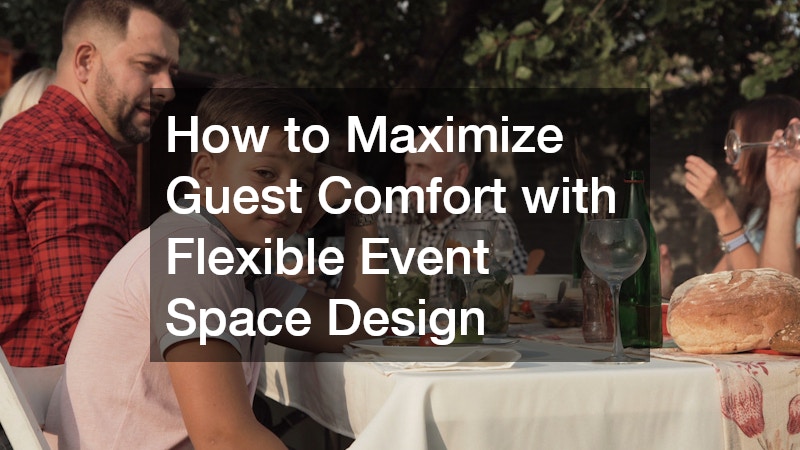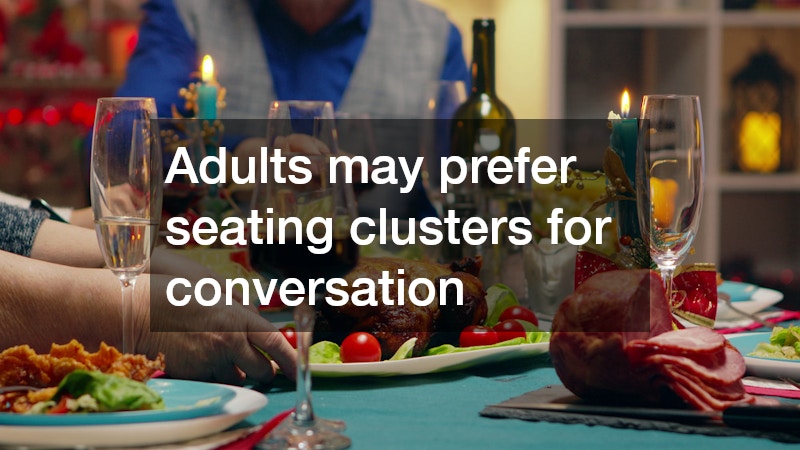
Highlights:
- Flexible event spaces with customizable layouts enhance guest comfort.
- Modular furniture and adjustable partitions allow for versatile setups.
- Proper lighting, climate control, and acoustics improve overall experience.
- Clearly defined zones for dining, activities, and relaxation reduce crowding.
- Accessibility and safety measures ensure all family members are accommodated.
- Thoughtful integration of technology supports entertainment and convenience.
- Outdoor and indoor spaces can be combined for added flexibility and enjoyment.

Hosting a family gathering, birthday party, or reunion requires more than just a venue—it demands an environment that prioritizes comfort, convenience, and flexibility. One of the most important considerations when planning a family event is the design of the event space. A thoughtfully designed venue can significantly enhance guest satisfaction, making your gathering memorable for everyone. Flexible event spaces with customizable layouts are key to achieving this goal, allowing hosts to adapt the environment to suit the specific needs of their guests.
In this article, we’ll explore the principles behind maximizing guest comfort through flexible event space design. We’ll examine how families can benefit from event spaces with customizable layouts, explore practical design tips, and provide actionable advice to ensure your next event is both functional and enjoyable for all attendees.
Understanding Flexible Event Spaces
A flexible event space is a venue that can be reconfigured to meet a variety of needs and accommodate different types of events. For families, this flexibility is especially valuable because it allows for adjustments based on the age, preferences, and mobility of guests.
Key aspects of flexible event spaces include:
- Movable furniture: Chairs, tables, and seating can be rearranged to suit different group sizes or activities.
- Adjustable partitions: These allow hosts to create private areas or open up the space for larger gatherings.
- Multi-functional zones: Areas that serve multiple purposes, such as a play area for children that converts into a dance floor for evening entertainment.
- Customizable lighting: Lighting can be adjusted to create different moods or highlight certain areas of the venue.
By leveraging these features, families can ensure their guests feel comfortable and engaged throughout the event.
Benefits of Customizable Layouts for Family Events
Customizable layouts are essential in family-focused events because they allow hosts to tailor the space to the unique needs of their guests. Some of the key benefits include:
- Enhanced guest comfort: Flexible seating arrangements can prevent overcrowding and ensure everyone has a personal space.
- Improved accessibility: Configurable layouts make it easier for elderly guests, children, and individuals with mobility challenges to navigate the space.
- Adaptability for activities: Whether it’s a birthday party, family reunion, or casual gathering, adjustable layouts allow hosts to create zones for dining, entertainment, and relaxation.
- Ease of social interaction: By adjusting seating arrangements, hosts can encourage conversation and interaction among guests of all ages.
In short, an event space with customizable layouts ensures that the environment is comfortable, functional, and enjoyable for all attendees.
Planning Your Event Layout

Before arranging furniture and equipment, it’s important to plan your layout carefully. Effective planning can prevent discomfort and logistical issues during the event. Here are steps to consider:
- Assess guest needs: Determine the number of attendees, their ages, and any special accommodations they may require. Families with young children or elderly members will benefit from spacious layouts with clear pathways.
- Identify activity zones: Separate areas for dining, entertainment, and relaxation can help prevent overcrowding and maintain flow.
- Consider circulation: Guests should be able to move freely between zones without obstruction. Flexible event spaces often include modular furniture that can be shifted as needed.
- Plan for flexibility: Leave room for adjustments during the event. Children may need space for games, while adults may prefer seating clusters for conversation.
Bullet points for a family-oriented event layout:
- Dining area with a combination of long tables and small clusters for conversation
- Play zone for children with soft flooring and interactive toys
- Lounge area with comfortable seating for grandparents or elderly guests
- Entertainment or stage area that can double as a dance floor
- Storage space for coats, bags, or strollers
Furniture Selection and Arrangement
The choice of furniture and its arrangement are critical in maximizing comfort in family events. When selecting furniture, consider:
- Modular seating: Sofas, benches, and chairs that can be rearranged easily.
- Child-friendly furniture: Low tables, padded chairs, and seating with rounded edges to prevent injuries.
- Comfortable options for elderly guests: Chairs with armrests and sufficient back support.
- Tables for versatile use: Nesting or folding tables that can be moved or adjusted for dining, crafts, or games.
Suggested arrangements for families:
- U-shaped layouts: Encourage interaction and allow easy supervision of children.
- Circular seating: Promotes conversation and inclusivity.
- Zoned clusters: Separate areas for different activities, keeping high-energy activities away from quieter zones.
Lighting and Climate Control
Lighting and climate control play a significant role in guest comfort. Even the best furniture and layout can fall short if the space is too hot, cold, or poorly lit.
- Natural light: Large windows or skylights can make the space feel open and welcoming.
- Adjustable lighting: Dimmer switches or smart lighting systems allow hosts to change the mood throughout the event.
- Task lighting: Ensure sufficient lighting over dining areas, game zones, and workspaces.
- Climate control: Adjustable heating and cooling systems maintain comfort for all guests, especially in mixed-age groups.
Tips for family-friendly lighting:
- Use soft, warm lighting for relaxing zones
- Add bright, direct lighting in activity or dining areas
- Consider night lighting for events that extend into the evening, ensuring pathways are illuminated
Acoustic Considerations
Sound can make or break the comfort of a family event. In flexible event spaces, acoustic planning is essential.
- Soundproof partitions: Prevent loud activities from disturbing quieter zones.
- Soft furnishings: Rugs, curtains, and upholstered furniture absorb excess noise.
- Background music: Light music can create a pleasant atmosphere, but avoid volume levels that interfere with conversation.
- Zoning for noise: Place high-energy activities away from quiet lounges or dining areas.
Accessibility and Safety
Families often include children, elderly members, or guests with mobility challenges. Prioritizing accessibility and safety in your event space design is crucial.
- Wide pathways: Ensure clear circulation to prevent accidents.
- Non-slip flooring: Protects both children and older adults.
- Accessible restrooms: Design layouts with convenient access to facilities.
- Emergency considerations: Clearly mark exits and maintain a first aid kit on site.
Bullet points for family-focused safety measures:
- Remove sharp-edged furniture from play areas
- Use childproof locks for cabinets and storage spaces
- Ensure temporary partitions or dividers are stable and secure
- Provide seating for elderly guests to prevent fatigue
Technology Integration
In today’s world, technology can enhance family events when used thoughtfully. Flexible event spaces with customizable layouts often integrate technology to improve comfort and engagement:
- AV systems: Adjustable audio and video setups for presentations, movies, or games.
- Charging stations: Ensure guests can keep devices powered, especially in family events with children.
- Smart controls: Remote lighting, climate, and sound management can simplify hosting duties.
- Wi-Fi access: Reliable connectivity allows streaming, games, and coordination of activities.
Catering and Food Zones
Food is central to family gatherings, and thoughtful planning of dining areas is key to comfort. Flexible event spaces allow for a variety of dining setups:
- Buffet stations: Allow guests to serve themselves at their own pace.
- Family-style tables: Encourage interaction and make it easy to share meals.
- High chairs and booster seats: Accommodate younger children comfortably.
- Snack stations: For casual or ongoing access during extended events.
Consider spacing tables to allow movement, keeping children’s eating zones near activity areas for convenience.
Outdoor and Indoor Integration
If your event space includes outdoor areas, integrating indoor and outdoor spaces can enhance guest comfort:
- Flexible partitions or sliding doors: Seamlessly connect indoor and outdoor zones.
- Outdoor seating: Provide shaded seating areas for hot weather.
- Activity zones: Use outdoor areas for games, crafts, or social spaces, while maintaining supervision.
- Weather adaptability: Tents, umbrellas, or retractable awnings protect against rain or sun.
Entertainment and Activity Planning
Flexible event spaces with customizable layouts allow hosts to organize entertainment in ways that suit all family members:
- Children’s activities: Craft stations, small play areas, or supervised games.
- Adult activities: Lounge zones for conversation, trivia games, or group activities.
- Evening options: Music, dancing, or movie screenings in transformable areas.
- Intergenerational options: Activities that encourage interaction between children and older family members, such as board games or family storytelling sessions.
Tips for Maximizing Comfort
Here’s a consolidated checklist for families planning an event in a flexible space:
- Evaluate guest needs and accessibility requirements
- Create clearly defined zones for different activities
- Use modular furniture to adjust layout as needed
- Prioritize lighting, climate control, and acoustics
- Plan food and dining zones with space for movement
- Ensure safety with wide pathways, stable furniture, and emergency access
- Integrate technology thoughtfully to enhance guest experience
- Include options for both quiet and active areas
- Incorporate outdoor spaces for variety and additional comfort
- Allow flexibility to rearrange spaces as the event unfolds
Closing Thoughts
Maximizing guest comfort in a family event begins with a well-designed space that can adapt to changing needs. Flexible event spaces with customizable layouts provide the tools necessary to create a welcoming, functional, and enjoyable environment for everyone. By considering furniture, lighting, accessibility, acoustics, and activity planning, families can ensure that all guests—from toddlers to grandparents—experience comfort and convenience throughout the event.
Ultimately, thoughtful planning and strategic use of flexible space design transform ordinary gatherings into memorable experiences. Whether it’s a birthday, family reunion, or casual get-together, a space designed with comfort and flexibility in mind helps foster connection, enjoyment, and lasting memories for the entire family.